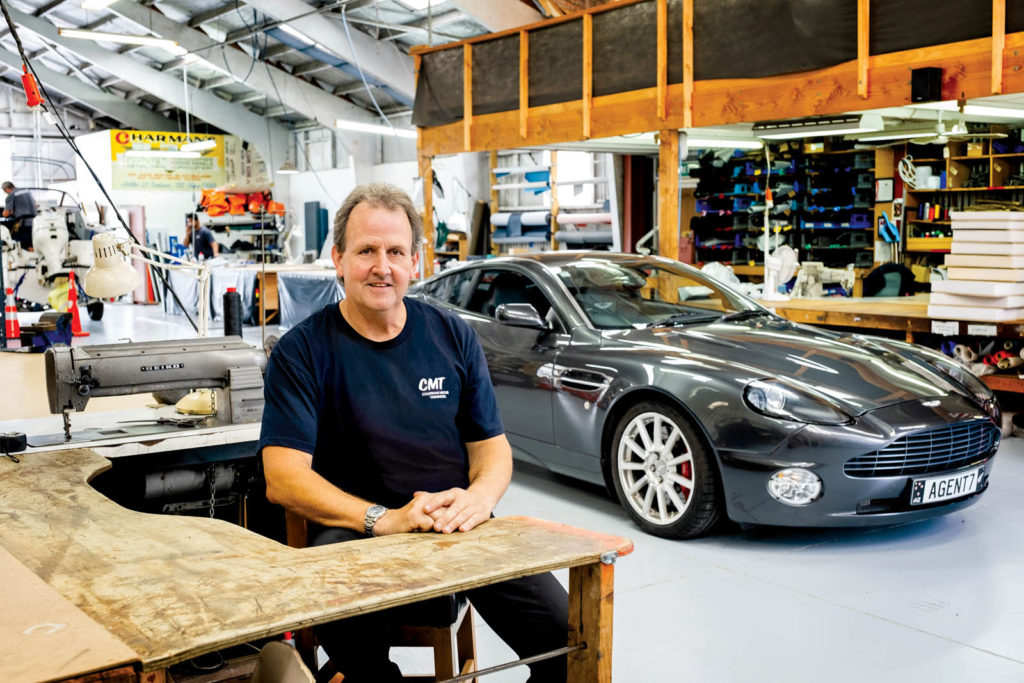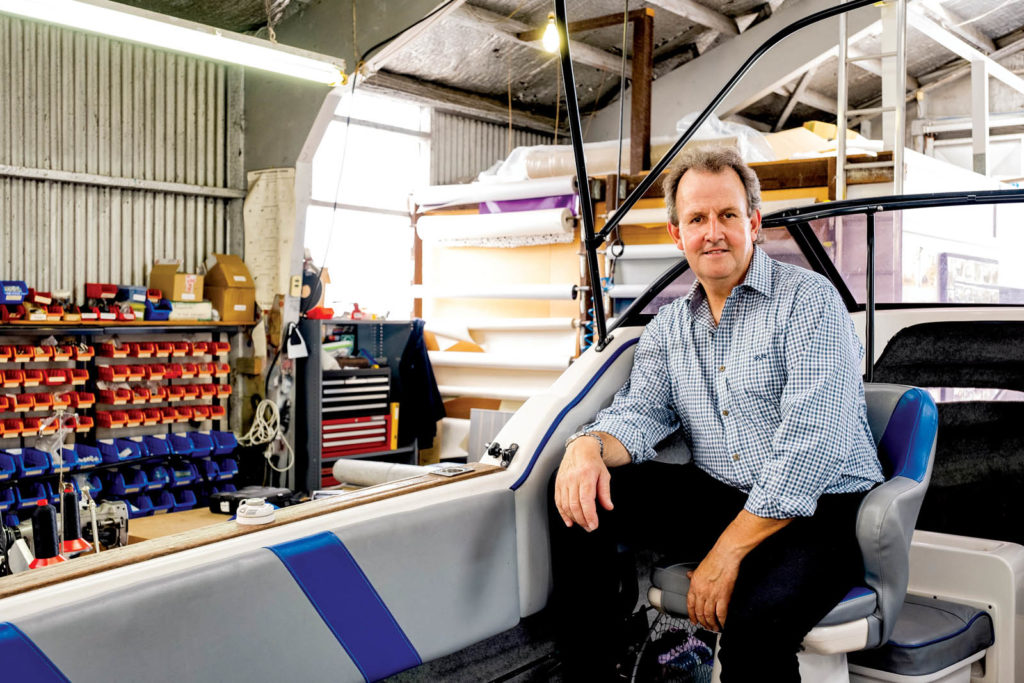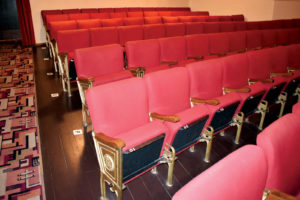With a growing business and a dearth of skilled labor, Kimber Buglass trains his own employees, fostering project ownership and pride in the job.

“Treat every job as if it’s your own job,” says Kimber Buglass, owner and managing director of Charman Motor Trimmers and Upholsterers Ltd. “I try to tell the team to be proud of whatever you make. You’re putting my name and your name on it. If it’s not what you would want at your home, then don’t let it leave the shop. So that’s always been our philosophy. Treat every job as if it’s your own.”
Charman Motor Trimmers was founded in 1976 in Napier, New Zealand, as an upholstery and automotive trimming shop. In that same year, a 15-year-old Buglass joined the company as an apprentice. Buglass’s mother had a background in curtain-making and upholstery, and the work struck him as something that might interest him. Buglass rose in the company to foreman, then manager, and finally owner with his wife Jocelyn Buglass upon the death of the company founder in 1997.
“I started my apprenticeship as an auto upholsterer,” Buglass says. “We used to do sheepskin seat covers on buses. It was a big thing back in the 1970s because the tourists liked soft seats, and we grew the business from there into motorbikes, seat covers and a little bit of canvas work. That was our first 10 years, and we diversified after that.”
Motorcycle seat covers, with logos screened in-house, became a path to expansion beyond New Zealand, as the company connected with partners in Australia and the United Kingdom. As the popularity of outdoor living grew, the company took on more shade sail, outdoor blind and canvas work.
Finally, given the business’s location on the coast of New Zealand’s north island, growth in the marine fabrication market was a natural fit. Today, the company offers everything from full re-trims on cars, to marine seating and carpeting, to residential and commercial shade products and other custom work.

Award winners
Along with its growth into diverse markets, Charman has expanded from four to 11 employees. One of the achievements Buglass is most proud of is that, after starting as an apprentice himself, he has trained 17 apprentices, four of whom have been honored with Apprentice of the Year awards from the Outdoor Fabric Products Association of New Zealand (OFPANZ). The apprenticeships are facilitated through New Zealand’s Motor Industry Training Organization (MITO). Following a three-month trial, apprentices undertake about three years of on-the-job training and correspondence and online work. But despite the robust apprenticeship program, the business’s primary challenge is finding employees, Buglass says.
“There’s no one out there, hence that’s why we train our own,” he says. “If I want to get more staff in, the challenge is getting someone with a background in this industry. Even if they’ve just got a bit of knowledge, it would help, and then we’ll train them our way.”
While some employees are cross-trained, most specialize in a particular market segment. And on any job, the employee working on the project is responsible for all stages from start to finish.
“The customer goes to that one person; they’re not talking to five or six different people or going through the office,” he says. “I find our system works really well: ‘It’s your job; you see it through. If you want help, you get the other team members in the factory to come and give you a hand.’ So that’s our point of difference. I think that’s where we turn the work over quicker.”
A custom approach
With two boat builders in the same industrial area as the Charman factory, the company has grown from fabricating boat covers into custom seating, carpeting, bimini tops and other projects.
“We have HF plates with the customers’ logos on it, and we emboss into the vinyl their branding name on each seat,” he says. “We have all the dyes made up especially for them. The branding gives it that professional look, when you see the logo on the outside of the boat, and then the logo pressed into the vinyl seating.”
Charman’s has also recently patterned and installed SeaDek® boat flooring. “And we have just completed New Zealand’s largest pontoon SeaLegs boat fit-up, on a SL 1170 Senator, with custom seating, lining walls and SeaDek.”
On the shade side, the craftsman whose specialty is shade sails has introduced the use of 3D imaging into the process of selling the job.
“If you have a proper 3D image of the house, the property and the sail, it looks so much nicer,” Buglass says. “We find that connecting to our audience on social media helps. And our website is updated all the time.”
Whatever the market, the craftsmen and craftswomen of Charman Motor Trimmers take a custom approach.
“Everything we make is handmade,” Buglass says. “The customer might come up with an idea, or they’ve seen a drawing or something, then we take that concept and discuss it with them, show them the materials, make a plan, cut it out, make it and give the article back to them. You can buy some of the things we make off the shelf, but [the off-the-shelf products] are mass-produced and not made to last. The majority of our customers understand that we can make most things within reason.”
Smooth operation
When it comes to new equipment and technology, Buglass determines whether it will fit into the shop’s workflow, or if it makes more sense to outsource a particular task. But he finds that once he’s invested in a new piece of equipment, the factory tends to find jobs for it. That’s where he sees the value in trade organizations—both the exposure to new technology, and the stories about how other companies grapple with the same challenges he faces.
“You think, ‘Well, that’s my business; I’m the same as that,’” he says. “I see what he does and how he does it; I see they are growing. To me, it’s reaffirming that other people out there are doing what we do. You always think that there’s someone out there ahead of everyone else. I believe we are all pretty much on the same page.”
More than 43 years after deciding that the auto upholstery trade was something he might be inclined to master, Buglass’s days are mostly spent managing the company—organizing the jobs that are coming in, ordering stock, preparing price quotes, and other management and administrative tasks.
“I do try to get on the floor maybe six to seven hours a week, if I’m very lucky,” he says. “I like to work with the guys and see what’s going on in the factory. They just bounce ideas off me and I bounce ideas off them. They run their own divisions really—I’m just a guy who tries to make sure things run smoothly.”
Jill C. Lafferty is associate editor on the Review.

While some of the products fabricated by Charman Motor Trimmers end up on the other side of the globe, one of the larger projects the company has ever taken on is one that Charman owner Kimber Buglass can regularly enjoy and take pride in: the refurbishing of the seats in the historic Napier Municipal Theatre.
The original theater, designed by leading Australian architect William Pitt in 1912, featured an Italian Renaissance style. Sadly, it was destroyed in the 1931 Hawke’s Bay earthquake, along with virtually all buildings in central Napier. The theater was rebuilt within the decade, this time in an Art Deco style. Today, Napier is a destination for tourists drawn to Art Deco and other popular architectural styles of the 1930s when the city was rebuilt, and the theater is a centerpiece of that heritage.
In the 1990s, the city began a process of refurbishing the theater, turning to Charman for the seating portion of that work. The seating design needed to retain the Art Deco style, using the existing arms and wrought iron legs; but unlike the original, it needed to include a spring system (so the seat returns to an upright position automatically when a person rises) and use fire-retardant materials. “They gave us one seat, and they asked us to design it,” Buglass says. “And we designed it and gave it back to our local council here, and the council put it through to the architects. The architects liked the design, so then it was sent away for the tipping system.”
Once the seat design was approved, the refurbishing project took two years, with 1,000 seats being restored in the Charman factory.
“I’ve been to the theater many a time and they haven’t changed,” Buglass says. “The seating has looked exactly the same; that’s one of the feathers in our cap, you could say.”
 TEXTILES.ORG
TEXTILES.ORG


